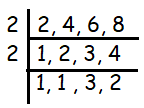PRODUCT RULE OF EXPONENTS
Product Rule of Exponents :
When multiplying exponential expressions that have the same base, add the exponents.

Simplify each of the following.
Example 1 :
a ⋅ a2 ⋅ a3
Solution :
Using product rule am × an = am+n
= a ⋅ a2 ⋅ a3
= a1+2 ⋅ a3
= a3 ⋅ a3
= a3+3
= a6
Example 2 :
(2a2b)(4ab2)
Solution :
= (2a2b)(4ab2)
Multiply the coefficients,
= (2 × 4) (a2b) (ab2)
= 8(a2b) (ab2)
Combining like terms,
= 8(a2 ⋅ a) (b ⋅ b2)
By am × an = am+n, we get
= 8(a2+1) (b1+2)
= 8a3b3
Example 3 :
(6x2)(-3x5)
Solution :
= (6x2)(-3x5)
Multiply the coefficients,
= (6 × (-3)) (x2) (x5)
By am × an = am+n, we get
= -18(x2+5)
= -18x7
Example 4 :
b3 ⋅ b4 ⋅ b7⋅ b
Solution :
= b3 ⋅ b4 ⋅ b7⋅ b
= b3 + 4 + 7 + 1
= b15
Example 5 :
(3x3) (3x4) (-3x2)
Solution :
= (3x3) (3x4) (-3x2)
While multiplying monomials, we have to follow the order
i) multiplying the signs
ii) multiplying the coefficients
iii) multiplying the variables
= 3 × 3 × (-3) (x3) (x4) (x2)
= -27 (x3 + 4 + 2)
= -27 x9
Use the product rule to rewrite each expression as a single exponent.
Example 6 :
(-5)-10 ⋅ (-5)15
Solution :
= (-5)-10 ⋅ (-5)15
= (-5)-10+15
= (-5)5
= 1/(-5)5
= -1/55
Example 7 :
Solution :
Example 8 :
(1.4)-12 ⋅ (1.4)5
Solution :
= (1.4)-12 ⋅ (1.4)5
= (1.4)-12+5
= (1.4)-7
By changing the negative exponent to positive exponent, we get
= 1/(1.4)7
Example 9 :
Solution :
Example 10 :
(-13)0 ⋅ (-13)-19
Solution :
= (-13)0 ⋅ (-13)-19
= 1⋅ (-13)-19
= 1/(-13)19
= -1/1319
Example 11 :
8-14 ⋅ 84
Solution :
= 8-14 ⋅ 84
= 8-14+4
= 8-10
By changing the negative exponent to positive exponent, we get
= 1/810
Find the value of x :
Example 12 :
10x ⋅ 10-9 = 1011
Solution :
10x ⋅ 10-9 = 1011
10x-9 = 1011
Since bases are the same, equate the powers.
x - 9 = 11
x = 11 + 9
x = 20
Example 13 :
Solution :
Example 14 :
(-2.9)-13 ⋅ (-2.9)x = (-2.9)-5
Solution :
(-2.9)-13 ⋅ (-2.9)x = (-2.9)-5
(-2.9)-13+x = (-2.9)-5
Since bases are the same, equate the powers.
-13 + x = -5
x = -5 + 13
x = 8
Example 15 :
The human body has about 100 billion cells. This number can be written in exponential form as
(a) 10–11 (b) 1011 (c) 109 (d) 10–9
Solution :
1 billion = 1,000,000,000
1 billion cosist of nine zeroes
100 billion = 100000000000
100 billion consists of eleven zeroes, then writing it in exponential form we get
= 1011
Option b is correct.
Example 16 :
(-2)3 ⋅ (-2)7 / (3 ⋅ 46)
Solution :
= (-2)3 ⋅ (-2)7 / (3 ⋅ 46)
= (-2)3+7 / (3 ⋅ ((2)2)6)
= (-2)10 / (3 ⋅ 212)
= 210 / (3 ⋅ 212)
= 1 / (3 ⋅ 22)
= 1/12
Example 17 :
The value of (–2)2×3 –1 is
(a) 32 (b) 64 (c) – 32 (d) – 64
Solution :
= (–2)2×3 –1
= (–2)6 - 1
= (–2)5
= –25
= -32
Example 18 :
(2-1+ 4–1 + 6–1 + 8–1)x = 1
Solution :
(1/2 + 1/4 + 1/6 + 1/8)x = 1

2 x 2 x 3 x 2
LCM (2, 4, 6 and 8) = 24
(1/2 + 1/4 + 1/6 + 1/8)x = 1
((12 + 6 + 4 + 3)/24)x = 1
(25/24)x = 1
(25/24)x = (25/24)0
x = 0
Example 19 :
Find the value of x–3 if x = (100)1 - 4 ÷ (100)0
Solution :
x = (100)1 - 4 ÷ (100)0
x = (100)-3 ÷ 1
x = 1/1003
x = 1/(102)3
x = 1/106
x-3 = (1/106)-3
x-3 = (1/106)-3
x-3 = (106)3
x-3 = 1018
Example 20 :
By what number should we multiply (–29)0 so that the product becomes (+29)0.
Solution :
The value of (–29)0 is 1. Because anything raised by the power 0 is 1.
(–29)0 should be multiplied by 1, so we will recieve (+29)0.
Example 21 :
By what number should (–15)–1 be divided so that quotient may be equal to (–15)–1?
Solution :
By observing the question and answer, we recieve the same answer. Any number divided by 1 will recieive the same number as result.
So, the required number is 1.
Example 22 :
Find the multiplicative inverse of (–7)–2 ÷ (90)–1
Solution :
= (–7)–2 ÷ (90)–1
= (90)1 ÷(–7)2
= 90/49
Multiplicative inverse of 90/49 is 49/90
Example 23 :
If 53x–1 ÷ 25 = 125, find the value of x.
Solution :
53x–1 ÷ 25 = 125
53x–1 ÷ 52 = 53
53x – 1- 2 = 53
53x – 3 = 53
3x - 3 = 3
3x = 3 + 3
3x = 6
x = 6/3
x = 2
Recent Articles
-
Finding Range of Values Inequality Problems
May 21, 24 08:51 PM
Finding Range of Values Inequality Problems -
Solving Two Step Inequality Word Problems
May 21, 24 08:51 AM
Solving Two Step Inequality Word Problems -
Exponential Function Context and Data Modeling
May 20, 24 10:45 PM
Exponential Function Context and Data Modeling